Top 10 Baits and Patterns from Havasu
Sight-fishing and “just fishing” both worked
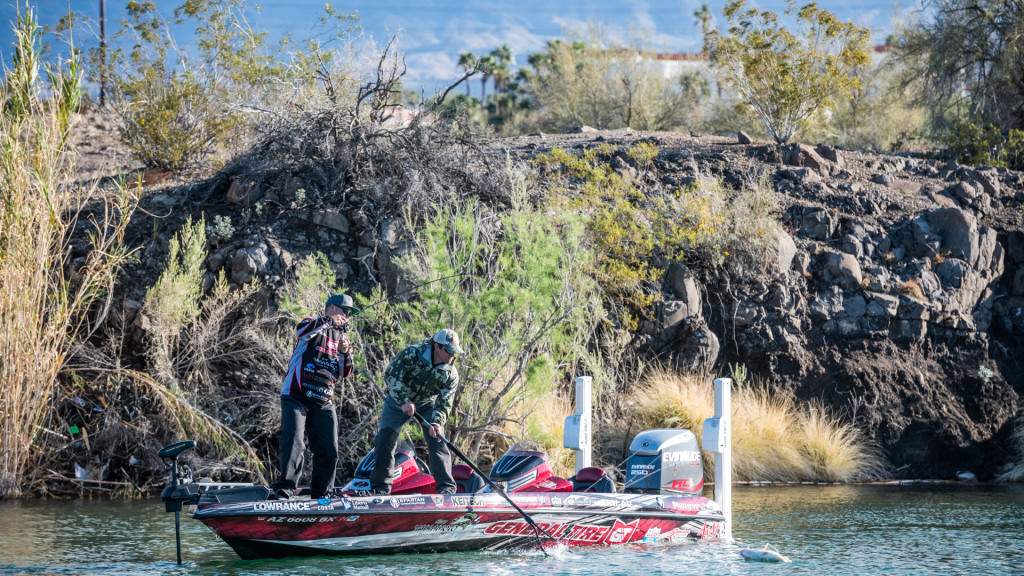
Results from the Toyota Series Western Division event at Lake Havasu probably didn’t surprise any Western anglers who are familiar with the fishery. For folks in other parts of the country that might only have followed FLW’s early February events on the Colorado River reservoir, the tournament results might have opened some eyes to just how good the fishing can be on Havasu. Particularly on day one, the lake delivered, kicking out 12 limits of more than 20 pounds, including Tai Au’s limit of 26 pounds, 1 ounce. The success on day one resulted from a perfect storm of conditions for catching spawning bass on beds.
Unfortunately, conditions changed on days two and three following a major storm that rolled through Thursday afternoon and evening. Catching fish didn’t exactly get hard, but it was nowhere near as easy.
Au, of Glendale, Ariz., won the tournament by capitalizing on the sight bite on day one. Then he went into scramble mode and junk-fished for the next two days. By the time it was over, he’d bagged 61 pounds, 3 ounces of bass – almost 7 pounds more than the winning weight on noted bass haven Lake Okeechobee in Florida, where another Toyota Series event was contested simultaneously.
Here’s a rundown of what the top 10 pros used to catch their fish, as well as some important pattern details. Of note is that most of the top 10 caught their fish in the mid- and lower sections of the lake. The upper portion – “the river” – was blown out by the heavy rains.
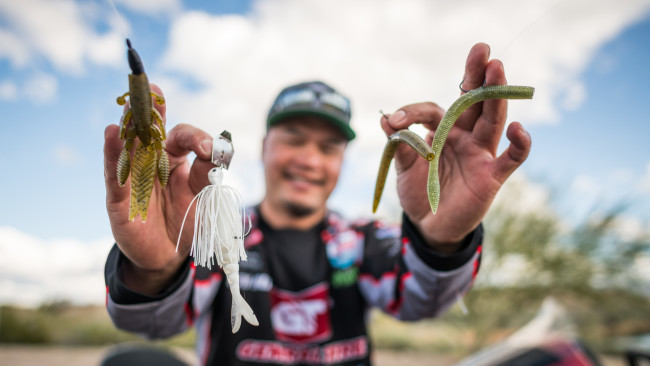
1. Au sight-fishes, junk-fishes
Au rotated through a variety of baits to catch the winning fish, including a Z-Man/Evergreen ChatterBait Jack Hammer with a Yamamoto Zako Paddle Tail trailer, a Texas-rigged Yamamoto Flappin’ Hog for flipping, a Yamamoto Senko and a Daiwa Yamamoto Neko Fat.
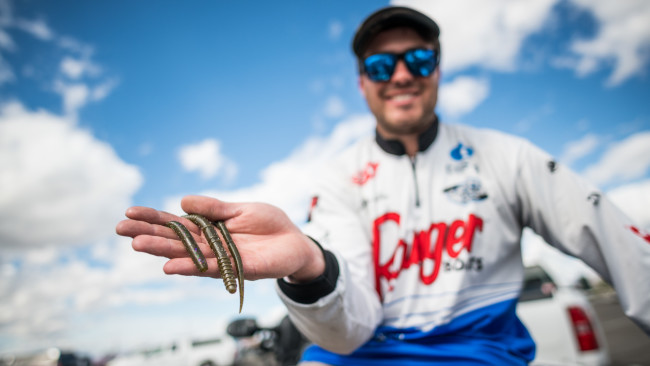
2. Collom goes all in on finesse
Jordan Collom opened the event with a whopping 25-15 limit. Then, like just about everyone else, he found the bite to be much tougher. His next two limits weighed 16 pounds and change.
All week, he ran to the south end of Havasu to blind-cast wacky rigs around spawning areas. It was painfully slow fishing. On the final day, he also caught two fish around floating docks in a marina.
“[I fished] secondary points on the way into spawning flats,” he says. “In practice I saw so many big ones, and I knew the bed fish were going to go quick. But I saw big females sunning their eggs, and they usually suspend on that first little point or first little cut before you get to the back. So that’s what I was targeting.
“I just ran new water every day looking for the same thing. Rick and Kyle Grover told me ‘never fish the same spot twice,’ so today [Saturday] I fished somewhere I haven’t fished in over a year.”
Collom says a wacky rig was king for him this week. He started with a 5-inch Yamamoto Pro Senko (green pumpkin) then added in a JMC Baits Superworm (green pumpkin) on day two. On day three, he went back to the Pro Senko and fished it both on a weightless wacky rig and a neko rig with a tiny piece of lead nail weight. When he fished the docks the final day, Collom used a drop-shot with a JMC Drop Shot Worm.
Notable for Collom is that he caught almost 26 pounds the first day using 5-pound-test fluorocarbon. He kept his casts far enough away from shoreline cover that he wouldn’t have to worry about getting hung up and breaking off and was able to fish that way due to Havasu’s clear water, which allowed the fish to easily see his bait from a few feet away.
“Those wacky rigs sink so slow that a fish is going to swim out to eat it,” he adds.
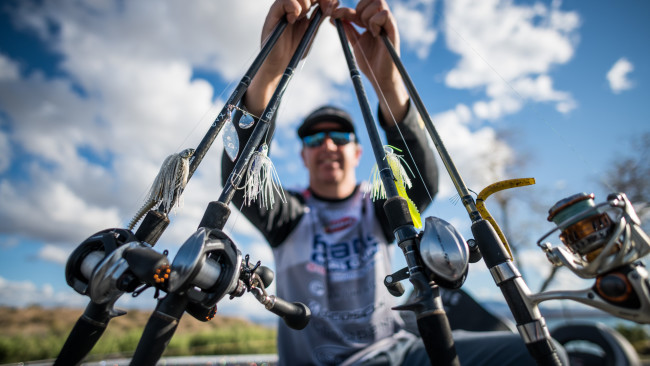
3. Kline makes major final-day push
Todd Kline began the final day in 10th place and made a real run up the leaderboard by swinging for the fences on Saturday. His strategy change the final day was to sling some moving baits and to sight-fish the protected waters of the Lake Havasu Marina.
“Sitting in 10th, It’s kind of like a basketball game. You can jack up three-pointers because you’re so far behind. If they go in, you’ll have a shot,” he says. “So I pulled a bit of a Hail Mary. I went and threw some big baits, some reaction, and was able to get a few fish.”
At one point, Kline thought he’d hooked the kind of fish that would make the winning difference. He was working a 2-pounder on a bed when another fish snatched his bait and immediately raced under the boat. After an intense fight, Kline was able to raise the fish enough to see it was an 8-pound carp. Foul-hooking another big female bass on a bed (foul-hooked bass must be returned if they’re caught while sight-fishing) was an equally heartbreaking experience, considering Kline had one small bass in his final limit and wound up less than 4 pounds back of Au.
On days one and two, Kline was “just throwing Senkos.” Though he sight-fished a couple off beds, he says his primary tactic was to mark any bass he saw cruising and then come back later and fish for them by staying off the bank and casting to the area where he saw them.
“Then you knew there were fish there,” he says. “I think anytime here on the Colorado River, there’s a lot of dead water. So when you see fish, you’ve got to put your time in there.”
Kline’s other baits included a 6-inch Roboworm Straight Tail Worm on a drop-shot, a Revenge Colorado Willow Spinnerbait and a Revenge Swim Jig with a swimbait trailer.
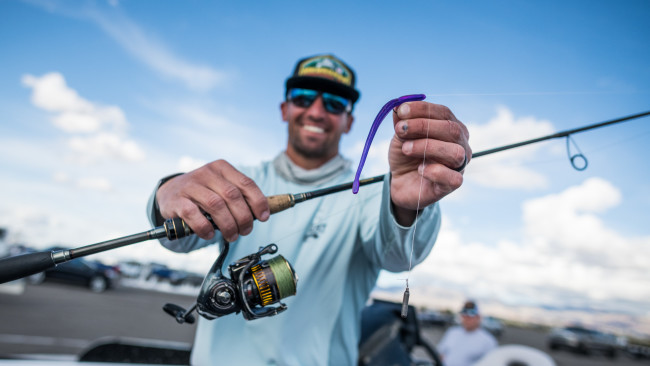
4. Michael Caruso sight-fishes and “just fishes”
Michael Caruso had himself in position for a chance to win this event, but a brutal final day where “everything that could go wrong went wrong” derailed his hopes. He lost almost two hours trying to catch a 6-pounder that would not eat, then had to deal with battery issues the rest of the day. It was all he could do to salvage a limit and only drop one spot in the standings.
“I looked at enough fish that I could win if I could catch them, but today [Saturday] I couldn’t catch them,” he says. “I don’t know if it was the conditions or what, but I just couldn’t get them to bite.”
Caruso found new fish moving up on Saturday and says that some of the old beds he’d located previously reloaded with fish.
On days one and two, Caruso split his time sight-fishing and “just fishing” through spawning areas that fit a pattern.
“It seemed like they wanted deep water with some trees hanging over. It seemed like all the better fish I saw were around trees and cuts that were kind of short. So they [the cuts] were deep in the middle and were short in length.”
He caught the majority of his fish on a 6-inch Roboworm Straight Tail Worm (margarita mutilator) on a drop-shot. When sight-fishing, he opted for a white 3 1/2-inch Roboworm Zipper Grub on a 3/0 EWG hook.
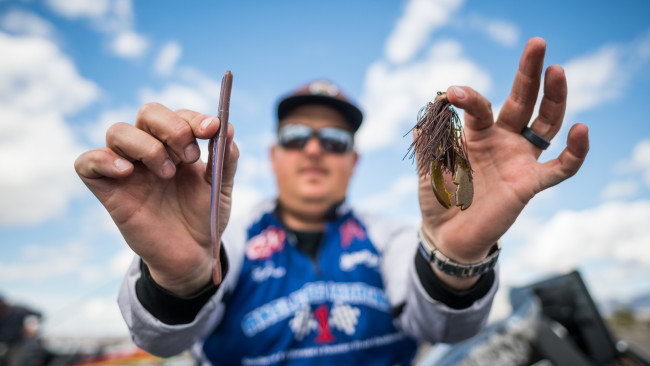
5. Grover sight-fishes most of his catch
California’s Kyle Grover sight-fished most of his catch the first two days. He enjoyed the same relatively easy fishing on day one as many others in the field. On day two, when things got tougher, he still was able to make the program work by focusing on the last half-mile of the reservoir down south, where the water is clearer and he was able to tuck into some protected pockets to stay out of the wind.
“I just got a little bit lucky. I had some fish marked that I thought guys would’ve caught the first day because there were so many boats down there,” he says. “And yesterday [Friday] I went down there and they were all still there. I couldn’t believe it. I caught a 5-pounder yesterday that I think had just moved up that really helped.”
On day three, fishing was much tougher due to fishing pressure and wind. Grover just went fishing. He threw a drop-shot and flipped, and he caught one on a jig.
His key baits this week were a 6-inch Roboworm Straight Tail Worm (peoples worm) and a 1/2-ounce brown Phenix Pro-Series Football Jig with a Berkley PowerBait Chigger Craw trailer (green pumpkin). He also flipped one on a Strike King Rage Bug.
When bed-fishing, Grover rigged his drop-shot on 12-pound-test line with a 1/2-ounce weight and the worm about 3 inches above the weight.
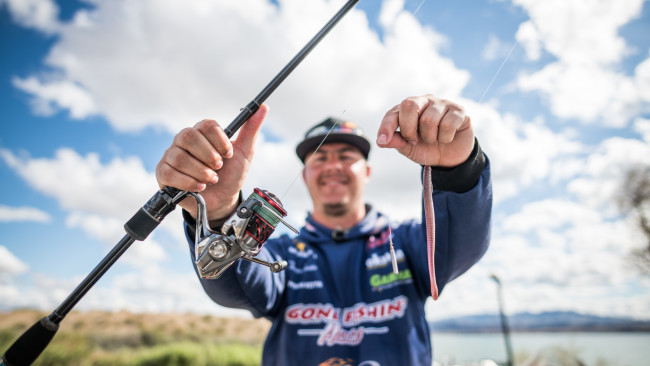
6. Austin free-falls docks with a drop-shot
Due to a final-day drop in weight, it wouldn’t be fair to say that Tanner Austin enjoyed the most consistent fishing of anyone in the top 10. However, it’s accurate to say he was most consistent with his pattern and location.
Austin spent the entire tournament fishing floating docks in Lake Havasu Marina. He simply caught all there was to catch and ran out of fish by Saturday. The 15 bass he weighed in included two smallmouths.
“I went in there on Monday for practice, and I caught one that was about 4 pounds not sight-fishing,” Austin says. “I couldn’t catch them any other way, so I just went in there and tried to catch as many as I could.
“In the morning, the outside of the docks seemed to be more productive. As soon as the sun got up, you’d have to cast your bait as far as you could back into the dock to get it up in the shade. That was pretty key to me. And the docks without any boats were more productive than docks with boats in them.”
Austin fished a 6-inch Roboworm Fat Straight Tail Worm (oxblood light red flake) on a drop-shot with 8-pound-test Gamma fluorocarbon tied as a leader to 15-pound-test FINS braid. He fished the drop-shot on a “straight free-fall,” letting his bait go to the bottom in 6 to 8 feet of water.
“I wouldn’t move the bait at all,” he says. “I’d throw it in there and just wait for a bite. If you moved it too much they wouldn’t bite it. You could let it sit for maybe 15 or 20 seconds, maybe twitch it once, and then they would usually bite it. A lot of twitching was not the deal at all.”
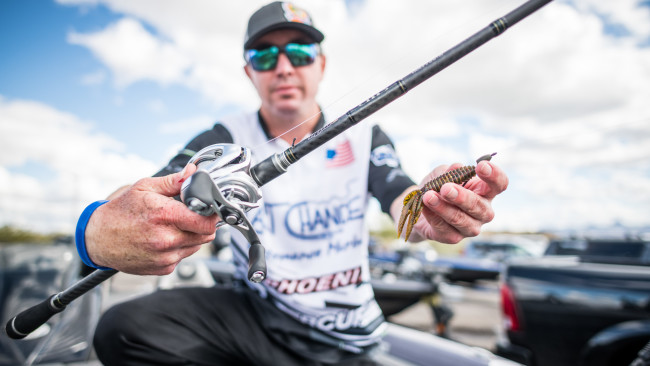
7. Hugo flips, bed-fishes
Kevin Hugo made the top 10 by sight-fishing on day one and flipping on day two. The final day, he started in Lake Havasu Marina and then went flipping. His fish just got smaller.
“I thought the flipping bite was going to be good again,” he says. “We got too much wind I think. The water color changed up. A lot of clear stuff was stained; stained stuff got clear. I ended up getting one about 5 pounds on a spinnerbait. The rest were about 2-pounders. My co-angler got one about 5 1/2 on a spinnerbait. So I probably should’ve just thrown the spinnerbait.”
Hugo had his best luck in pockets with dead tules or a combination of rock and cedar trees.
“The bigger the bay the better,” he says, adding that most of his fish were in the last third of the bays.
Hugo used a 1/2-ounce War Eagle Colorado/willow spinnerbait (mouse) on the final day. When bed-fishing, he tossed a Little Creeper Sunfish or a 4 1/2-inch Roboworm Curly Tail Worm (bold bluegill) on 7-pound test. Hugo flipped a Reaction Innovations Sweet Beaver in green pumpkin red flake with a little orange dye. He Texas-rigged it with a 3/8-ounce weight on 20-pound-test fluorocarbon.

8. Eslick wacky rigs tules
Clayton Eslick ran a simple, productive pattern the first two days. He was throwing a weightless 5-inch Yamamoto Senko (green pumpkin/watermelon laminate) on a No. 2 Decoy wacky rig hook (the small hook helped “disguise” it in clear water). On the final day, he had to adjust.
“I saw them cruising the tule line during practice, so I just stayed back. They were all good ones. Everything worked the first two days,” he says. “With the wind [on day three] it changed that bite a ton. It was windy and cold, and I think it just pushed them out of the tules. I had to start catching them on the outside edge instead of the inside.”
On the final day, Eslick also flipped, and he wound a Z-Man ChatterBait Custom. He used a small hair jig at times, too.

9. Kevin Caruso sight-fishes in “do-nothing” areas
Kevin Caruso makes up the elder half of the Caruso father-son duo in the top 10. His son is fourth-place finisher Michael Caruso.
Like Michael, Kevin fished his way to the top 10 in large part by sight-fishing. Unfortunately, motor issues hampered him on Saturday, and he had to make a long idle back to takeoff and fish close to the ramp just to scratch out a limit.
Prior to that, Kevin was on the trail of some truly large bass, including a 6-pounder that he sight-fished on day one.
“I just strictly was looking for beds the whole practice,” he says. “I spent five days looking in the water. I fished probably 30 minutes a day – max. The areas that my biggest fish came out of, I never even went to before [this tournament]. The day before the tournament, I found all those fish.”
Kevin figured out that he wasn’t the only one to have previously overlooked those areas. They aren’t popular bed-fishing pockets. That worked to his advantage in the tournament because he mostly had them to himself.
“There was a lot less pressure in those,” he says. “They were just ‘do-nothings.’ That’s why I’d never fished them before. You look at it and go, ‘That’s ugly-looking.’ There wasn’t a lot there, but the bass that were there were quality.”
He caught most of his fish on a drop-shot with either a 6-inch Roboworm Straight Tail Worm (margarita mutilator) or a Roboworm Zipper Grub (bed bait 2). He also caught two on a Yamamoto Senko (pumpkin red flake).
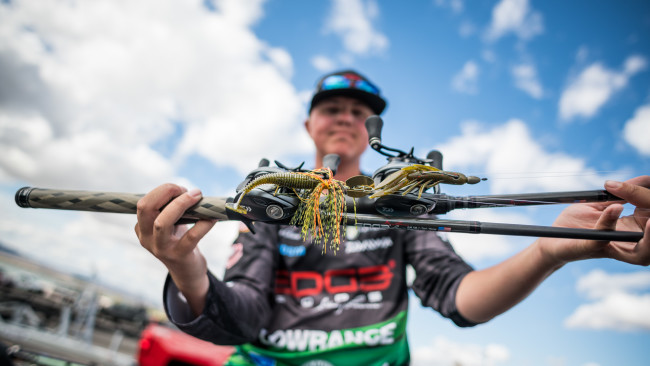
10. Olson sight-fishes and flips
Tackle Warehouse Pro Circuit pro Lane Olson had to skedaddle pretty quickly after the final weigh-in at Havasu to get to Alabama for the next Pro Circuit event, where he hopes his momentum from Havasu will carry him to back-to-back top-10 finishes.
At Havasu, Olson caught his fish sight-fishing on day one. On day two, he flipped reeds. On the final day, he says he “kind of went swinging” and flipped in an area where he knew there were some big ones. He caught five, but they didn’t live up to expectations in terms of weigh.
“Sight-fishing the first day, a lot of them got picked off really quick. I just ran out of bed fish,” he says. “The rest of the week, the water did get a little bit muddy, so you couldn’t really see. I just wasn’t having it, so I went upriver.”
Olson did most of his damage with a D&M Custom Baits Punch Craw (green pumpkin with black and red flake). He also caught a couple on a Little Creeper All American Trash Fish and a 1/2-ounce D&M Custom Bait Piranha II vibrating jig (bluegill).